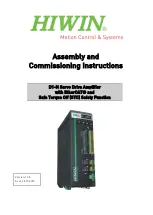
User’s Guide DMC-842
© RME
25
12. Remote Control
12.1 MIDI
The DMC-842 can be completely remote controlled via MIDI. It reacts on special SysEx com-
mands. Furthermore, upon request it will report the complete device status, including all con-
trols and LEDs on the front plate. Each DMC-842 can be programmed with its own ID, providing
a separated remote control of multiple devices via a single MIDI channel. A description of the
MIDI implementation is found in chapter 21.
The button REMOTE is used to select the source of the MIDI remote control commands: AES,
MIDI, MADI and Off. The latter is a safety function to prevent any setup-change by any MIDI
signal.
With an installed I64 MADI Card the DMC-842 can also be remote controlled via MADI. Status
information of the unit is sent to all outputs simultaneously. With an installed I64 MADI Card this
includes embedded information at the MADI outputs (see 12.2, MIDI over MADI).
The diagram shows the sig-
nal flow of the MIDI data with
all I/Os. The MIDI input signal
reaches both the internal
Remote Command Processor
and the MIDI outputs. This
MIDI Through
function pro-
vides the base for a simplified
serial MIDI cabling when
using multiple DMC-842s.
The same is true for remote
control via MADI, where MIDI
is passed through from de-
vice to device automatically via the serial MADI cabling.
12.2 MIDI over MADI
MADI allows for a transmission of 64 audio channels over long distances with a single line –
perfect. But what about MIDI? Be it remote control commands or sequencer data, in practice
only a single MADI line will not suffice. Daher entwickelte RME die
MIDI over MADI
Technolo-
gie. The data at the MIDI input are being included into the MADI signal invisibly, and can be
collected at the MIDI output of another DMC-842, ADI-8 QS, ADI-6432 / 642 / 648, Micstasy or
a HDSP MADI, at the other end of the MADI line.
Technically every single MADI channel includes several additional bits, containing various in-
formation (Channel Status). RME use the usually unused
User bit
of channel 56 (channel 28 in
96k frame mode), to transmit MIDI data invisibly within MADI, ensuring full compatibility.
Unlike other MADI-based devices from RME, the DMC-842 is no bi-directional MIDI to
MADI converter, because only one direction is available for the transmission.
Summary of Contents for DMC-842
Page 5: ...User s Guide DMC 842 RME 5 User s Guide DMC 842 General...
Page 12: ...12 User s Guide DMC 842 RME...
Page 13: ...User s Guide DMC 842 RME 13 User s Guide DMC 842 Usage and Operation...
Page 29: ...User s Guide DMC 842 RME 29 User s Guide DMC 842 Inputs and Outputs...
Page 39: ...User s Guide DMC 842 RME 39 User s Guide DMC 842 Technical Reference...















































